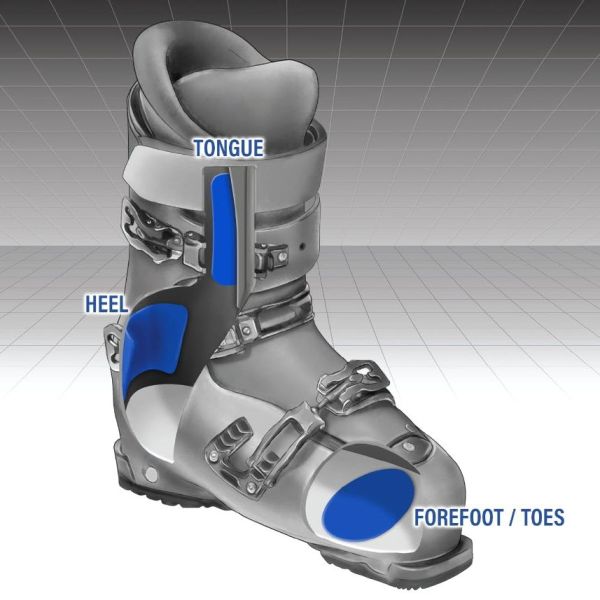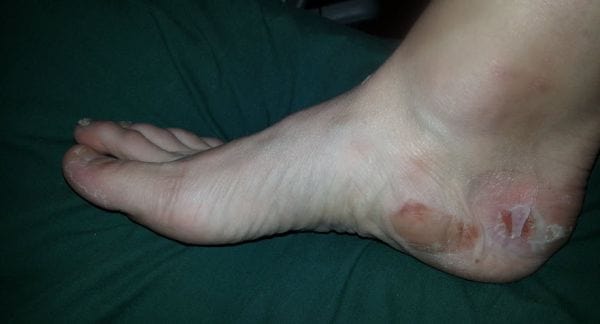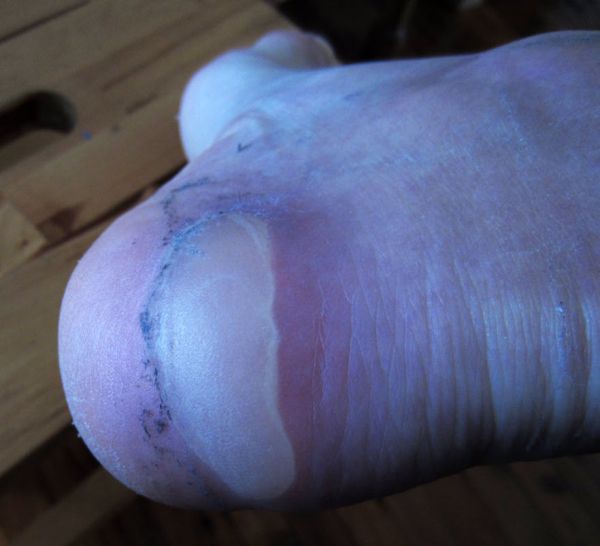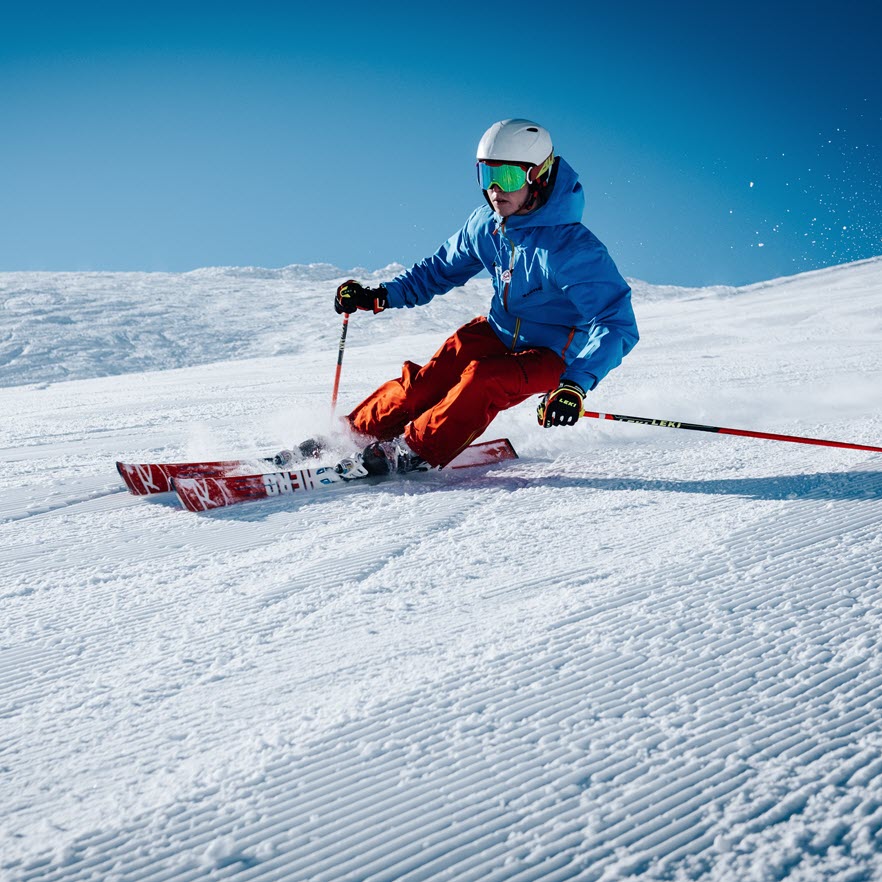Skiing is a popular winter sport enjoyed by people all over the world. Some people are lucky enough to live near the ski fields. Other plan their vacations around it and travel abroad. From alpine and nordic skiing to ski-touring, skiing comes with its own set of foot and leg injury challenges. One of these is the development of friction blisters. In this article, we'll explore the prevalence of foot/leg blisters in skiing, the factors contributing to them, and what skiers are doing to prevent and treat them. Having no experience myself with skiing of any persuasion, I embarked on a fact-finding mission and enlisted the expertise of a few colleagues who have a special interest and significant exposure to the ski scene, the different types of skiing sports, both recreational and competitive, and ski boot fit.
- Gareth Milne and Patti Barnes from Southern Sports Podiatry in Queenstown, NZ. Gareth and Patti are obviously well and truly immersed in the New Zealand skiing scene and likely to have insight into the types of foot injuries suffered by locals and visitors presenting for podiatric services.
- Steven Parkinson from The Foot Hub in Sydney. After gaining his podiatry qualifications, Steve worked in Japan and New Zealand for 3 seasons, fitting ski boots. You can check out his specialist ski boot fitting service here.
-
Dr Ned Buckley, Perth podiatric surgeon and owner of several ski stores in Japan. Ned came into podiatry having worked many years in ski retail. His stores include:
- Custom ski boot fitting store Boot Solutions Japan
- Village Sports Japan
- Cole Carlson from Minnesota, USA. Cole works at Tamarack Habilitation Technologies Inc where ENGO Blister Patches were conceived and are still manufactured today. Cole is an avid nordic (cross-country) skier and racer who spends around 10 hours a week on the trails during either training or competing.
Types Of Skiing
There are different types of skiing, exerting different forces onto the feet.Nordic/Cross-Country Freestyle (V-shape)
- 2023 US Nationals - Men's 10K Freestyle - YouTube
Nordic/Cross-Country Classic (Parallel)
- 2023 US Nationals - Men's 20K Classic - YouTube
Alpine Touring (Ski-Touring)
- Correcting the Three Most Common Mistakes People Make Ski Touring in the Backcountry - YouTube
Alpine/Regular Skiing
- How To Ski With Flow | 3 Tips for smoother skiing - YouTube
Factors Contributing to Ski Boot Blisters
There are several factors that contribute to the development of foot blisters in skiing. Most of them are easily understood.1. Poorly Fitting Boot, Liner and/or Footbed
Poor ski boot fit was unanimously identified as the most likely cause of blisters, particularly boots that are too big. This comes down to the fit of the shell, the liner and the footbed, which are purchased as a single unit. For skiing, it is imperative that the boot fits snug and doesn’t press on any bony protuberances. Specifically, a snug fit prevents any forward-backward / upward movement of the foot, leading to pivot points and concentrations of pressure. Ned highlighted that perfect ski boot fit would be considered too small for a running or walking shoe fit. This tight fit is tolerated due to the padding and compressibility of the liner and footbed. The combination of correct sizing, correct fastening and customised liner is the holy grail of ski boot fit and the prevention of ski boot blisters.- Size – The boot itself, or shell, is a rigid and impervious polyurethane plastic material. Choosing the right boot, in length, depth and width for your anatomy, is of utmost importance. Get this wrong and you’re making it unnecessarily difficult for yourself. Steve Parkinson expanded upon this, saying all ski boot manufacturers offer sizes at 1cm increments and widths/volumes at mm increments using the mondopoint sizing system to accommodate different foot shapes. You can learn more about mondopoint sizing here. The volume of the boot differs between different brands and models at the upper cuff, heel pocket, instep height and toe box shape. The decision made here is the most important. Spend some time trying them on and get the assistance of a specialised ski boot fitter to help you make the right choices.
- Fastening – Like any form of footwear, there’s no point having a perfectly sized and shaped shoe if you don’t optimise the way you attach it to your foot. With ski boots, this comes down to the buckles which fasten over the foot and in front of the shin. And the power strap at the top of the boot which helps prevent excessive movement of your shin relative to the boot.
- Liner – The liner, including the footbed (insole) is the most customisable part of a ski boot. This customisation is performed by heating the liner (heat gun, oven or microwave) to make it more malleable, putting the boot on, and allowing it to cool, thereby conforming to the shape of your foot/leg anatomy. All of the podiatrists I interviewed who have worked in ski boot fitting in Japan and New Zealand indicate virtually every liner is heat-molded or customised in some way. This is at odds with Cole’s experience in Minnesota, as a nordic skiing consumer. He has found little to no heat molding is performed on nordic ski boot liners, but it is much more common with alpine ski boots. Liners can be made from many different materials, including basic foams, neoprene, wool, thermo-molding foam, liquid, injectable foams and cork.
2. Moisture
The other obvious factor is moisture. Ski boots are impervious to water, naturally. However, water can get in. Steve suggests overlap, or traditional 4 buckle alpine downhill ski boots, are the most susceptible to letting water seep into the boot especially when snow accumulates on top of the boot for long periods on ‘powder days’. Cole suggests 90-95% of moisture in the boot comes from perspiration. If you know anything about blisters or skin friction, you’ll know that moisture increases friction force on the skin. Things get sticky and clammy in there at the best of times. The longer you’re in those boots and the more you’re exerting yourself, the more moisture your feet are producing. Sure, the physical exertion in alpine skiing occurs in fits and starts. However, cross-country skiing is intensely vigorous at the best of times. Consider the effort required to move in soft snow and moving uphill! Add a competitive racing environment, it's easy to see the feet will be perspiring a lot. And that moisture has no way of escaping, unlike running shoes with ventilating mesh uppers. Drying liners and footbeds between ski days is a priority, so you’re at least starting the next day with dry feet. This is done in a drying room with the liner removed from the shell, or with boot dryers (ie: thermic, sidas or hotronics boot dryers).3. Repetition/Duration
This leads on nicely to another necessary aspect of blister formation - repetition. Sure, in regular alpine skiing, a fair bit of time is spent in line or on the chair lift. In cross-country skiing and ski-touring, the activity and duration would be closer to that of a hiker or even a runner going for a long-distance run. But skiers are doing this in rigid, impervious, tight-fitting ski boots! For up to 8 hours a day. Spare a thought for ski-instructors too!4. Unconditioned Skin
Many nordic and alpine skiers ski regularly. The skin of their feet, ankles and lower legs will be well-conditioned to the shear loads that occurs in skiing. For others less fortunate to live in close proximity to their skiing location, skiing is likely to be something they do irregularly. And then there are people who skin once or twice a year on skiing vacation. It’s not difficult to understand how their skin is be quite unconditioned. The fact is, skin becomes more resistant to blisters the more it is subjected to shear loads.5. Amount Of Walking In Boots
Every one interviewed mentioned the amount of walking in ski boots as a significant factor for blister formation. Walking distance from the carpark, from your accommodation or from the bottom of the slope to the chair lift can be significant. The foot cannot possibly work as intended for efficient gait (to be explained next in the next section). Ski boots are not made for walking, notwithstanding ski-touring boots that unclip at the heel and pivot at the toe tip. Even then, the boot doesn’t flex across the ball of the foot like your foot.Ski Boot Blister Locations
The back of the heel was unanimously identified as the most common blister site. This is particularly so when there is considerable walking performed in the ski boots. Efficient walking requires sagittal plane motion (flexion/extension) of the hip, knee, ankle and forefoot joints. While the hip and knee are able to flex unimpeded when wearing ski boots, the ankle is significantly restricted and forefoot joints cannot flex at all. They will attempt to flex, merely for the fact the hip and knee have flexed and the objective is to stride forward. There will be compression of the padded components of the foot and leg into the liner and footbed as a result. With optimal snug fit, peak pressures will be minimised due to the large surface area afforded by that full contact. If boot fit is not optimised, even small amounts of movement of the foot/leg relative to the boot, less total contact area will mean higher peak pressures in certain areas. Steve Parkinson explains further that blisters are not common in downhill alpine boots, owing to the nature of the skiing. They are far more common in boots a significant amount of time is spent walking (walking up hill with touring boots or side country ski boots with walk mode engaged or hiking backcountry or skating on flat cat tracks (pushing with back leg) in snowboard boots). Cole from Minnesota suggests from his experience, blister location depends on the type of skiing. During freestyle cross-country skiing, he personally gets blisters under and along the edge of the medial longitudinal arch of his foot, owing to the “V” shaped action. Propulsion occurs with the hip externally rotated and abducted, and the foot abducted (out-toed) in the transverse plane as a result. Compare this to walking where propulsion occurs in the sagittal plane through the big toe and weight is transferred to the opposite leg that swings straight through. ENGO Blister Patches applied to the inside of the liner is how Cole combats these blisters. Shin blisters are something I've never seen before, but can understand how they could occur in ski boots. Apparently alpine skiers are more likely to suffer blisters on the shins, and tops of the toes. Steve has seen abrasions and tissue bruising on the shins when skiers make the mistake of tucking their leggings or gaiters into the upper cuff of their boot, or wearing socks that lack sufficient cushioning. There were conflicting thoughts about blister incidence in snowboarding, from most common to the least common ski sport to suffer this skin injury, due to the relative softness or 'give' in the boot in this area. Gareth and Patti report they rarely sees shin blisters, but will more often see shin bursitis, commonly called shin bang. A few solutions to shin bang are discussed in the video below.Other sites mentioned were the lateral forefoot, malleoli (ankle bones) and bony protuberances like bunions and around the navicular bone. Modification to the liner is key to minimising excessive pressure here. Ned describes how padding is often added to the foot for the heat-molding process. The result will be a larger depression in the liner to effect reduced peak pressure in this area. Padding can also be added to boot liners to improve heel hold and decrease heel lift within the boot. However, the shell can also be modified, too. Steve describes how the ski boot fitter can grind the shell or ‘punch’ (stretch) the boot to accommodate bony prominences and reduce compression where required. Additionally, fore-aft and lateral canting can be adjusted to improve pressure distribution and performance.
Blister Preventions In Popular Use
I’m told specific blister prevention products are not sold in ski shops, which I find surprising and in direct contrast to running and hiking retail outlets. Unlike hikers and runners who frequently either tape, use lubricants, Compeed, moleskin and the like directly on the skin, blister prevention products are not widely available. Having said that, Ned mentioned that ski-tourers often have duct tape in their kit or wrapped around one of their poles, serving many purposes, from fixing broken skis to blister prevention or treatment – adhered straight onto the skin! They often carry a first aid kit but minimising bulk and weight is an important consideration, so gear is kept to a minimum. Adding cushioned paddings and donut pads to the skin is generally avoided due to the additional bulk in an already tight situation. However, footbeds can be replaced with customised versions with various degrees of wedging and to redistribute pressure from problem areas. And paddings can be added to the tongue of the liner to optimise fit (tongue shim). Simple dressings or single layers of tape are unlikely to add significant bulk, yet there is anxiety in adding anything extra inside the boot.Adhesive Products Inside The Liner
Applying adhesive products to the inside of the liner or on top of the footbed poses an obvious problem. When the foot is pushed with force into the liner (which is already in the boot), the sock-covered foot is likely to catch the leading edge of the padding and dislodge it. This includes felt, adhesive gel cushioning dots, ENGO Patches or PelliTec Pads. Steve has used ENGO Patches for skin irritation at the navicular and malleoli with some success. And Cole uses rectangle ENGO Patches adjacent to the arch irritation he suffers. But he agrees that owing to the method of donning the boot and the amount of moisture in the boost, conditions aren't favourable for the durability of these friction-reducing patches.
Alternative Donning Methods
Whether it's felt, moleskin, fleecyweb or a PelliTec Pad to help cushion or hold the heel still in the boot. Or a PelliTec or gel pad to absorb shear. Or an ENGO Patch to free-up a susceptible area of skin and reduce shear deformation magnitudes. Adhesive products applied to the liner may require an alternative boot donning method.- Boot-horn: The equivalent of a shoe-horn, a boot-horn is a large piece of plastic used to guide the foot/heel into the boot with relative ease. Pads and patches used around the heel would be spared from the dislodging force and the sock would not be able to catch the leading edge of the pad/patch, progressively compromising its adhesion with each donning episode.
- Liner first: Although not the standard way of donning a ski boot, I saw a video that mentioned it was possible with some boots to don the liner first. By opening the liner up to insert your foot, you would be more able to place protect the leading edges of those adhesive products adhered to the liner, maximising their longevity. Then of course, sliding your liner-covered foot into the shell, using a boot-horn if necessary. None of my colleagues were familiar with this method. However, this forum discussion suggests it’s not that unusual.
Ski Socks
The consensus is virtually all skiers should, and do wear socks. Socks provide cushioning, shear absorption, thermal insulation, and moisture-management functions. Skiers generally buy them based on their "moisture-wicking" function and/or their Merino wool composition, with synthetic/wool blends being popular. While there is no single go-to sock, popular brands include Icebreaker, Smartwool and Darn Tough. The relative benefits of thick versus thin (depending on whether you feel the cold or suffer from hot feet), padding throughout or in certain areas (shin, heel, toes) are talked about generally, less so in terms of blister prevention.Prevalence Of Skiing Blisters
Some skiers ski several times per week, including the pros, those training for an event, people on extended skiing vacations and those who are conveniently located close to the slopes and ski trails. Their skin would be quite conditioned to the activity. Separately, there would be a lot of people taking part in isolated episodes of skiing, ranging from a single day, to a weekend ski trip. Their skin will be wholly unconditioned to the shear loads their ski boots are about to impart to their feet and lower legs. Add to that, these people are more likely to hire ski boots and liners. Intuitively, these people are at higher risk of developing blisters. Either way, as Cole mentioned, there is considerable expense in spending a day on the slopes, let alone traveling interstate or abroad. He suspects if a person sustains a skin irritation of any sort, including blisters, they’re likely to put up with it, rather than let it stop them from skiing, if they can possibly help it. So, what are skiers doing to prevent and treat blisters to allow them to keep skiing in relative comfort? Are they just gritting their teeth and powering on? Or are blisters so uncommon as to be a non-issue? All of the podiatrists interviewed indicate they rarely see anyone specifically for skiing-related blister issues in their podiatry clinics. Even Gareth and Patti in the heart of Queenstown NZ rarely see ski boot blisters. They iterated that this complaint would normally present to the ski shop where further heat-molding takes place to improve conformity of the boot to the foot. This is usually done to the liner or footbed, but the shell can be heat-molded as a last resort. Indeed, ski boot stores that offer professional fitting all but guarantee perfect fit, so this is where you go to troubleshoot blister issues, if you had them.Skiing Foot Blister Email Enquiries
I hear from blister sufferers from all around the world who are involved in all sorts of activities. I tag the majority of support email strings with various tags, one of them being the person's activity. Since 2015, I’ve received only 8 emails from people relating to skiing blisters, which is rather low compared to other activities. Whilst ensuring their anonymity, here are a few specifics of their enquiry.- Two teachers involved in taking groups of high school students cross-country skiing and snow camping. “We recently invested in new ski boot liners and have been plagued by a large number of blisters mid arch. The students are carrying heavy packs on the first day and this seems to be when they get the blisters.”
- An experienced skier who got a blister whilst on a skiing holiday and downloaded our Blister Treatment Blueprint in an effort to heal them fast. “Got a blister cross country skiing at old faithful in Yellowstone Park. Had my boots for years and never got a blister before. Tried your treatment and its working. So, thanks for saving my vacation!”
- A well-known identity in the ski-touring industry who was looking for educational material as he said “Blisters are a common issue and can be a show stopper for a ski tourer.”
- A competitive skier with some “gnarly deroofed heel blisters” who was looking for the best treatment as “they are super painful and I must continue to ski in my very tight ski boots that apply pressure directly to the blister. What is the best solution? I fear adding a dressing will make a tight situation even tighter. Any recommendations?” He also downloaded our Blister Treatment Blueprint.
- A skier from the USA who said “I get blisters ALL. THE. TIME. I have extremely sweaty feet, so nothing sticks and stays in place, especially in ski boots since there isn't any ventilation. Any suggestions for ski boots and sweaty feet?” This was her blister situation at the time (below).

- A skier who used the ENGO rectangle blister patches to good effect on his ski boot liners.
- And this awful back-of-heel blister.
 That’s not a lot of skiing-related blisters in 8 years. But they include different locations, including the back of the heel, the heel edge and the arch. They come from novice and experienced skiers. And it’s clear they can be debilitating.
That’s not a lot of skiing-related blisters in 8 years. But they include different locations, including the back of the heel, the heel edge and the arch. They come from novice and experienced skiers. And it’s clear they can be debilitating.
Your Comments, Please!
Foot blisters are definitely a problem for some skiers. There are some very obvious reasons why. And you’ve heard from a number of people who have contacted me looking for answers. However, this is in stark contrast to the experience of specialist ski boot fitters, the lack of skiing blister complaints presenting to podiatrists, and the lack of availability of blister products in ski shops. Do you get blisters on the slopes, the trails or in the backcountry? Where on your foot or leg? What have you tried preventively - what worked and what didn't? How do you treat them? Or do you just put up with them? Are you a skier, work in ski retail, or a podiatrist and have a different experience? I’d love to hear from you. Please comment below and I’ll be sure to reply.
Skiing is a popular winter sport enjoyed by people all over the world. Some people are lucky enough to live near the ski fields. Other plan their vacations around it and travel abroad. From alpine and nordic skiing to ski-touring, skiing comes with its own set of foot and leg injury challenges. One of these is the development of friction blisters. In this article, we'll explore the prevalence of foot/leg blisters in skiing, the factors contributing to them, and what skiers are doing to prevent and treat them. Having no experience myself with skiing of any persuasion, I embarked on a fact-finding mission and enlisted the expertise of a few colleagues who have a special interest and significant exposure to the ski scene, the different types of skiing sports, both recreational and competitive, and ski boot fit.
My Skiing Enthusiast Colleagues Included:
- Gareth Milne and Patti Barnes from Southern Sports Podiatry in Queenstown, NZ. Gareth and Patti are obviously well and truly immersed in the New Zealand skiing scene and likely to have insight into the types of foot injuries suffered by locals and visitors presenting for podiatric services.
- Steven Parkinson from The Foot Hub in Sydney. After gaining his podiatry qualifications, Steve worked in Japan and New Zealand for 3 seasons, fitting ski boots. You can check out his specialist ski boot fitting service here.
-
Dr Ned Buckley, Perth podiatric surgeon and owner of several ski stores in Japan. Ned came into podiatry having worked many years in ski retail. His stores include:
- Custom ski boot fitting store Boot Solutions Japan
- Village Sports Japan
- Cole Carlson from Minnesota, USA. Cole works at Tamarack Habilitation Technologies Inc where ENGO Blister Patches were conceived and are still manufactured today. Cole is an avid nordic (cross-country) skier and racer who spends around 10 hours a week on the trails during either training or competing.








